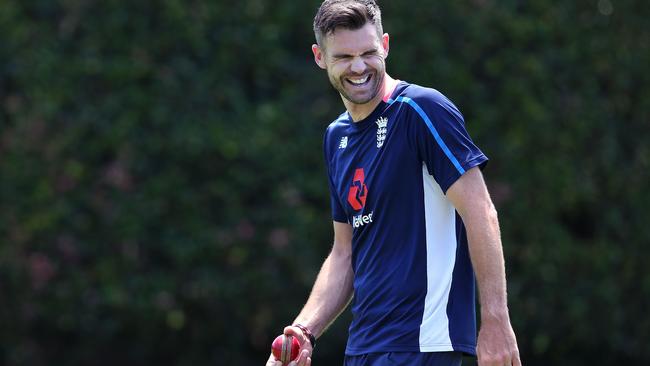Vale Jimmy Anderson, quiet, cranky craftsman
Australians never really warmed to the England quick, but they should take a moment this week to say a respectful farewell.

Australians have never warmed to James Anderson. The feeling may be mutual. In his autobiography, he recalls his first Test tour as uniquely unpleasant, in a social as well as a sporting sense: “Australia is home to some of the most poisonous creatures on earth, and most of them seemed to dwell on the streets of Sydney and Melbourne.”
Some time in the next few days, 35-year-old Anderson will take his last new ball for England in an Australian Test match, probably with few regrets — he’ll hardly be sought out for a testimonial by Kookaburra. Yet few cricketers of his time have been more stealthily remarkable.
So many records did Alastair Cook and Steve Smith leave in their respective wakes in Melbourne that another passed unnoticed. By playing his 133rd Test, Anderson became Test cricket’s most capped pace bowler, overtaking Courtney Walsh. The only bowler to have played more Tests is Shane Warne; the rest of those ahead of Anderson on the list, Jacques Kallis and Mark Boucher apart, are specialist batsmen.
Anderson has endured in his uniqueness too. At 188cm, he stands only 5cm taller than his boyish captain Joe Root. At 76kg, he weighs about the same as his bantamweight antagonist David Warner. He should hardly bowl 100km/h, let alone 135km/h.
These Ashes are an advertisement for fast bowling as an occupation for giants: both attacks are composed of towering men, while Australia is breeding monsters like Billy Stanlake and Peter George.
Anderson belongs to a more ancient lineage, of smaller figures, compact and rhythmic, like Ray Lindwall (178cm) and Harold Larwood (173cm), although he is more lightly built than either, while no cricket or conditioning coach would recommend the way he rotates his back and completes his action by looking at the ground.
Yet there is no evidence of his performances attenuating — on the contrary. Since turning 30, in an era of flat pitches, fat bats and machine-stitched balls, Anderson has taken 254 Test wickets at 24.15. In 2017 alone, he claimed 55 victims at 17: almost twice as many wickets at less than half the cost of his old confrere Stuart Broad, four years his junior. The skill he has polished to a remarkable lustre has been bowling at left-handers, and from over the wicket, departing the round-the-wicket angle that for a long time was a default mode among faster bowlers.
For a pace bowler, Anderson wastes nothing: his run is economical, his follow-through abbreviated, his walk-back brisk; he gets through overs in almost one continuous motion, as though to leave the batsman, like Rosencrantz and Guildenstern, no shriving time.
The problem for England this summer is that Anderson has not been able to bowl all the time, although he has done his best, delivering more overs (189.3) and giving up runs more grudgingly (2.2 an over) than anyone on either side. England had similar problems here four years ago. It is a damning comment on their cricket that while Australia has remade its attack almost entirely in the interim, English bowling still consists of Anderson, Broad, TBA, A. N. Other and Subject to the Crown Prosecution Service.
So why the reluctance to extend admiration? Anderson is partly penalised for his excellence at home. Using his own pitches, overhead conditions and cricket balls he has taken 335 wickets at 24.29; his record away is 187 wickets at 32.8, leading to his derogation as an “English bully”. Yet Mitchell Johnson paid 25 for his wickets at home and 32 away, and nobody here considers him an “Australian bully”. Nor, save in his career’s earliest stages, has the gap between Anderson’s best and worst ever been so pronounced as Johnson’s.
There is also that Anderson is a notoriously ornery opponent — proud, perfectionist, prickly. It does not seem anything personal. Anyone in range with a bat becomes a target. The first time they were formally introduced as English players, having previously only been county opponents, Cook noted: “The last time we met you called me a c. .t.”
It’s not obvious whether his verbals have ever actually intimidated anyone: Brad Haddin said he found that his opponent’s northern accent rendered Anderson’s sledging unintelligible. If anything they may have stimulated the competitive juices of others. In his autobiography, Chris Rogers noted that England’s verbal hostility in the 2013 Ashes inculcated a sense that “these guys need to be put in their place” in 2013-14.
In Anderson’s case, the on-field abrasiveness has in part been to compensate for an off-field reticence. Indeed, it has been cultivated with the help of psychologist Mark Bawden, so that the warrior persona “Jimmy” is distinguishable from the shy homebody “James”, whose friends of longest standing are those he made at the outset of his career at Burnley CC, his 185-year-old Lancashire League club.
This means, I suspect, that Anderson has never quite been able to negotiate dealing with opponents as anything other than that. There’s no deficiency in this — in some ways it is a form of sincerity, and it is an issue that each cricketer must solve according to their own lights. But it has, I think, hindered appreciation of an unusually diverse and thoughtful athlete.
This summer Anderson is contributing to an engaging BBC Radio 5 Live podcast, Tailenders, with his friend Felix White, founder of the indie pop group the Maccabees. He’s relaxed, dryly humorous, loyal to his team, and sometimes very insightful.
Anderson’s passion for music extends to his being a long-time supporter of a music therapy charity, Nordoff Robbins. He was also executive producer of an excellent documentary, Warriors (2015), about Kenya’s soul-stirring Maasai Warriors cricket team.
I happened to attend this film’s launch in London, and was struck by Anderson’s presence. He was clearly conscious that his involvement had drawn a sizeable proportion of the audience, yet equally abashed about it, and anxious not to distract from the work of the film’s director Barney Douglas. In such glimpses can be the measure of a man.
I wondered why the subject had appealed to Anderson. Perhaps it’s that, in his own way, he is also a tribal man, loyal and wary. It will be interesting to see how one who has expressed so much of his personality through cricket comes to terms with life beyond it; in the meantime, take the opportunity these next five days to study one of the game’s finest craftsmen.



To join the conversation, please log in. Don't have an account? Register
Join the conversation, you are commenting as Logout